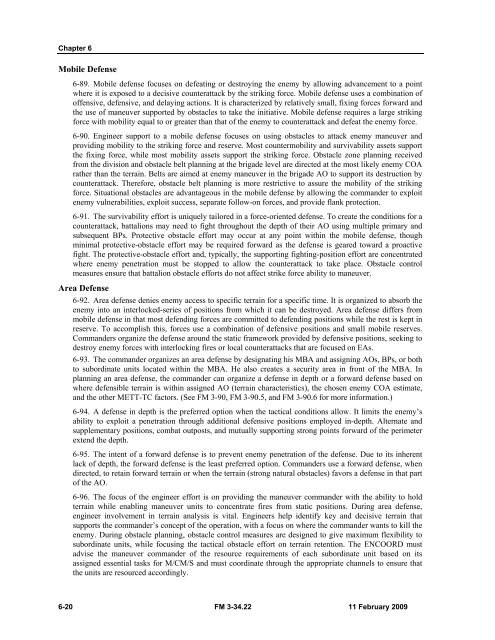FM 3-34.22 - Army Electronic Publications & Forms - U.S. Army
FM 3-34.22 - Army Electronic Publications & Forms - U.S. Army
FM 3-34.22 - Army Electronic Publications & Forms - U.S. Army
Create successful ePaper yourself
Turn your PDF publications into a flip-book with our unique Google optimized e-Paper software.
Chapter 6<br />
Mobile Defense<br />
6-89. Mobile defense focuses on defeating or destroying the enemy by allowing advancement to a point<br />
where it is exposed to a decisive counterattack by the striking force. Mobile defense uses a combination of<br />
offensive, defensive, and delaying actions. It is characterized by relatively small, fixing forces forward and<br />
the use of maneuver supported by obstacles to take the initiative. Mobile defense requires a large striking<br />
force with mobility equal to or greater than that of the enemy to counterattack and defeat the enemy force.<br />
6-90. Engineer support to a mobile defense focuses on using obstacles to attack enemy maneuver and<br />
providing mobility to the striking force and reserve. Most countermobility and survivability assets support<br />
the fixing force, while most mobility assets support the striking force. Obstacle zone planning received<br />
from the division and obstacle belt planning at the brigade level are directed at the most likely enemy COA<br />
rather than the terrain. Belts are aimed at enemy maneuver in the brigade AO to support its destruction by<br />
counterattack. Therefore, obstacle belt planning is more restrictive to assure the mobility of the striking<br />
force. Situational obstacles are advantageous in the mobile defense by allowing the commander to exploit<br />
enemy vulnerabilities, exploit success, separate follow-on forces, and provide flank protection.<br />
6-91. The survivability effort is uniquely tailored in a force-oriented defense. To create the conditions for a<br />
counterattack, battalions may need to fight throughout the depth of their AO using multiple primary and<br />
subsequent BPs. Protective obstacle effort may occur at any point within the mobile defense, though<br />
minimal protective-obstacle effort may be required forward as the defense is geared toward a proactive<br />
fight. The protective-obstacle effort and, typically, the supporting fighting-position effort are concentrated<br />
where enemy penetration must be stopped to allow the counterattack to take place. Obstacle control<br />
measures ensure that battalion obstacle efforts do not affect strike force ability to maneuver.<br />
Area Defense<br />
6-92. Area defense denies enemy access to specific terrain for a specific time. It is organized to absorb the<br />
enemy into an interlocked-series of positions from which it can be destroyed. Area defense differs from<br />
mobile defense in that most defending forces are committed to defending positions while the rest is kept in<br />
reserve. To accomplish this, forces use a combination of defensive positions and small mobile reserves.<br />
Commanders organize the defense around the static framework provided by defensive positions, seeking to<br />
destroy enemy forces with interlocking fires or local counterattacks that are focused on EAs.<br />
6-93. The commander organizes an area defense by designating his MBA and assigning AOs, BPs, or both<br />
to subordinate units located within the MBA. He also creates a security area in front of the MBA. In<br />
planning an area defense, the commander can organize a defense in depth or a forward defense based on<br />
where defensible terrain is within assigned AO (terrain characteristics), the chosen enemy COA estimate,<br />
and the other METT-TC factors. (See <strong>FM</strong> 3-90, <strong>FM</strong> 3-90.5, and <strong>FM</strong> 3-90.6 for more information.)<br />
6-94. A defense in depth is the preferred option when the tactical conditions allow. It limits the enemy’s<br />
ability to exploit a penetration through additional defensive positions employed in-depth. Alternate and<br />
supplementary positions, combat outposts, and mutually supporting strong points forward of the perimeter<br />
extend the depth.<br />
6-95. The intent of a forward defense is to prevent enemy penetration of the defense. Due to its inherent<br />
lack of depth, the forward defense is the least preferred option. Commanders use a forward defense, when<br />
directed, to retain forward terrain or when the terrain (strong natural obstacles) favors a defense in that part<br />
of the AO.<br />
6-96. The focus of the engineer effort is on providing the maneuver commander with the ability to hold<br />
terrain while enabling maneuver units to concentrate fires from static positions. During area defense,<br />
engineer involvement in terrain analysis is vital. Engineers help identify key and decisive terrain that<br />
supports the commander’s concept of the operation, with a focus on where the commander wants to kill the<br />
enemy. During obstacle planning, obstacle control measures are designed to give maximum flexibility to<br />
subordinate units, while focusing the tactical obstacle effort on terrain retention. The ENCOORD must<br />
advise the maneuver commander of the resource requirements of each subordinate unit based on its<br />
assigned essential tasks for M/CM/S and must coordinate through the appropriate channels to ensure that<br />
the units are resourced accordingly.<br />
6-20 <strong>FM</strong> 3-<strong>34.22</strong> 11 February 2009

















